« Another trip: testing cameras and some bad news | Main | More on taking pictures underwater »
February 26, 2007
More diving, finally!
It seemed like it had been forever since my last dive trip when I packed my bag for a late February trip to Northern Florida. Essentially I retraced the steps from my trip last fall, but added some new twists. In addition to just getting back underwater I wanted to learn more about caverns, learn drift diving, and do a lot more underwater photography.
By now I have read so much about caves and caverns that I am both intrigued and scared. I am also neither cave nor cavern certified (yet) and so can, legally, only get a glimpse of that special world. Fortunately, that is possible in the springs and sinks of northern Florida. There are even places where you can enter caverns with just an open water certification, such as "the cathedral" at Ginnie Springs. However, this sort of thing is not sanctioned by PADI or NAUI and so it all becomes an issue of signing waivers, knowing what you're doing, and not engaging in needless, and potentially deadly, risks. And I wasn't going to do any of that. Still, I knew that no matter what diving experience I'd have, it didn't matter. I just wanted to again feel the rush of being submerged, of floating weightlessly, of seeing and experiencing this different world that has opened to me and has been captivating me ever since I came across it. So I packed all my gear, hoped it would all make it okay, put all the essential stuff like regulator, dive computer and my cameras in a carry-on. That left very little space for clothes. Turns out, of whatever little I took, half I never even used. Divers don't need much in terms of clothes. A few pairs of socks, enough underwear (I use them under my wetsuit instead of bulky bathing suits), a pair of jeans, sneakers and a few T-shirts, is all.
Turns out all went well. My big dive bag made it to its destination and came around on the baggage carousel just as I walked up to it, fresh off the plane. Yeah. It had been opened and inspected by our friends from whatever US security agency is running our lives at airports these days, making sure we don't take little fingernail scissor and more than three ounces of toothpaste with us. Amazingly, my carry-on chuck full of electronic gear and hoses and housings and power supplies and cameras and wires and other exotic stuff was never questioned nor opened whereas my sneakers and Gateway laptop were suspiciously sniffed as potential terrorist materials.
Back at Devil's Den
Devil's Den will probably always hold a special fascination for me. It's where I began my NAUI advanced diver training for one thing, and it's a great place to dive. The setting is wild and picturesque, and though the crystal clear blue-green water of the sink itself looks so shallow, it's really not. The entrance through sheer rock and then a careful walk down a set of wooden stairs onto a platform on top of the debris cone in the center of the round surface of the sink lets you enter a wonderfully mysterious world.
Before we made it there I'd been afraid I'd have forgotten how to assemble and put on my scuba gear, but it all came back immediately. Maybe it is a bit like riding a bicycle. It was a beautiful day, sunny and warm without being too humid. My wetsuit went on a whole lot easier and even getting down all those steps in the full scuba gear seemed much less of a struggle than last Fall.
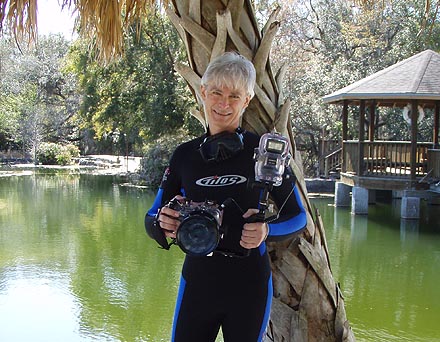
This time I'd brought along a different set of cameras, four in all, and for this first dive we chose the two very different models from Olympus. In fact, they couldn't have been any more different. The Evolt 330 digital SLR resides in a massive housing, its external flash has its own large housing, and the two are connected via a hefty, heavy metal bracket assembly that lets you twist and turn the flash any which way you want. I'd spent several hours going through the Olympus manuals, one each for each part of the vast assembly, and a few more acquainting myself with the whole setup. I concluded it'd be best to pretty much leave all settings on as automatic as possible. Once all geared up I also decided to let Carol with all her NAUI instructor expertise and experience in underwater shooting take a first crack at the Evolt (okay... she didn't have to twist my arm when she offered to carry the heavy rig down into the cavern) so that I could get used to it all again.
Me, I took along the waterproof Olympus 770 SW instead. As much attention as the massive Evolt setup in its clear acrylic housing and all its shiny buttons received each time I pulled it out and set it up, the little 770 was an even bigger attention getter whenever we unceremoniously plopped it into the water. Onlookers' reaction was always the same: they thought I'd neglectd to put the camera into its underwater housing, or simply forgotten to leave it onshore. Then it was on to explaining that this sleek little camera didn't need a housing and could, in fact, handle depths of up to 33 feet as it comes out of the box.
This time Devil's Den was fairly busy with perhaps eight to ten divers but the place is large enough for that not to be a problem. We carefully submerged the Evolt to test it for telltale bubbles that might indicate a leak. There were none. Ditto for the separate flash housing, also clear acrylic. We then did a buoyancy check on the heavy camera assembly. All hopes that it might turn out to be at least close to neutrally buoyant once in the water instantly disappeared. The thing sank like a brick. Oh well. Maybe a lighter bracket would help or a bigger housing, though it's big enough as it is.
We did a final check of our gear, made sure once again that the tanks' air valves were open, then held up the inflator and pushed the button to release air from our BCs to descend. I was surprised that there was none of the initial apprehension that I'd always felt on every dive before. I just went down, adjusted my buoyancy (I was loaded with a total of 12 pounds; a four on each front pocket and twos in the back) and began looking around. The sun shone through the cavern's small opening above and sent rays through the clear water. I saw other divers slowly appearing over the rocks, hovering in those rays and it looked just incredible. I snapped pictures of them just to find that the camera was still in above-water setting and the flash did nothing but illuminate scatter. I changed it to its proper underwater mode (the Olympus Stylus 770 SW has four - snapshot, macro, and two telephoto settings) and descended deeper. As I approached a depth of 30 feet, the camera beeped and flashed a red "depth warning" on its LCD screen. The 770 has a built-in manometer that shows depth in 1.5 foot increments. I later found that it only showed depths to 33 feet and no more.
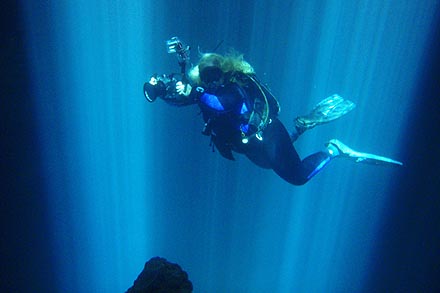
I must admit that I had decided to take the camera deeper than its design limit of 33 feet even before the dive, wanting to see what it would do. That wasn't just reckless behavior and an attempt to see how much the camera could take before it flooded. I was confident Olympus had engineered it so there was a good safety margin and the depth limit didn't confine divers too much. 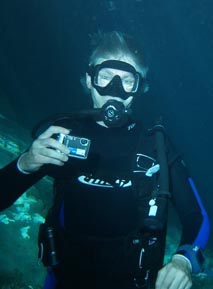 So I took it deeper, all the while watching its display to make sure it was still okay. 40 feet, 45 feet and all was well. No bubbles, no flickering, no other sign of distres from the sleek little Olympus.
So I took it deeper, all the while watching its display to make sure it was still okay. 40 feet, 45 feet and all was well. No bubbles, no flickering, no other sign of distres from the sleek little Olympus.
At this point we decided to explore some of the overhangs and venture a bit deeper under the rocks and into the nooks and crannies towards the bottom of the sink. We didn't get deeper than 40 feet last Fall, but this time I descended into a narrow cave-like descent that was indeed an overhead environment for some 30 feet or so. I had my handy magnesium LED flashlight with me. Carol motioned for my attention and reminded me to pull myself along the rocks as I had been shown before.
I never felt panicky or uneasy at all descending into the dark. At the bottom of the cave section I checked my dive computer and found, much to my delight, that we were at 51 feet. The Olympus seemed fine but when I tried to use the push button to toggle the camera into its scene selection mode to switch to the underwater macro setting it refused to do so. It also seemed like the 770 was all of a sudden in full 3X zoom mode. I took some pictures, then exited the cave section -- "cave section" is really an exaggeration; it's simply a brief overhead passage going down around the rock -- and began ascending a bit.
At about 40 feet I was able to change the camera settings again and then spent another 40 minutes or so exploring. We were shown some of the more interesting parts of the Den, including holes in the rock wall and also several sections that were either blocked off or had warning signs. I had often wondered if Devil's Den did not connect to a larger cave system as most sinks do, but I haven't found an answer yet though I asked several people. Carol, in the meantime was busy exploring the big Olympus Evolt setup and apparently had no problem at all with its size and negative buoyancy. I watched her exploring the camera and taking lots of pictures.
I marveled at all the large catfish swimming around. If any place should be called Catfish Hotel it should be Devil's Den. They are everywhere, majestically gliding around. And they are BIG. We saw "the Bus" again, the largest catfish I'd ever seen and wondered what they all eat. They are unafraid of divers, though they won't let you get close and don't generally pose for pictures.
We stayed down for almost an hour, until diving in the 70 degree water began feeling pretty cold. I wanted to go down again for one more lap around the debris cone at ten or 15 feet, but was immediately assaulted by a painful sinus headache, and so aborted the dive and came back up.
Out of the water I felt elated as I always do after dives. Walking up the steep stairs felt like nothing at all. The surface greeted us with bright sunlight and warmth, and I sat on a bench for 20 minutes or so, just basking in a wonderful feeling. My body felt great. It was a warm, satisfying glow. I felt very happy and contented. I contemplated how great diving was and how lucky I considered myself for having discovered it. Then I slowly made my way over to the park area where we had left our gear and got out of my wetsuit. The first dive of the new year had been great. We drove on to Crystal Springs to get ready for another Manatee tour early next morning.
Lenses
Oh, I should mention one other thing I learned at Devil's Den. It marked the first time I tried using Optx magnifying lenses in my Scubapro Frameless mask. I need reading glasses above water but so far had gotten by without special optics in my scuba mask. Still, while the magnifying effect underwater made it a bit easier to read the dive computer, that was only the case in good lighting conditions. When it got murky I could barely see what was on my Uwatec's smallish display. 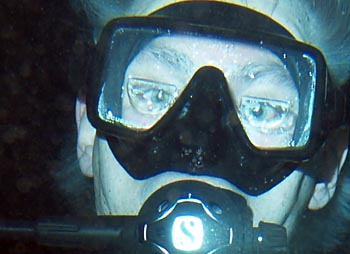 Not good. So before the trip I had finally applied the lenses I'd gotten from the Hudson dive shop in Rancho Cordova when it still existed. I followed the instructions when installing the lenses, let them dry for 48 hours and they stayed in place when I first flooded the mask. I looked down at my dive computer and, wow, I could read everything! Unfortunately, I couldn't see anything else. Everything was blurry as if my mask had gotten fogged up.
Not good. So before the trip I had finally applied the lenses I'd gotten from the Hudson dive shop in Rancho Cordova when it still existed. I followed the instructions when installing the lenses, let them dry for 48 hours and they stayed in place when I first flooded the mask. I looked down at my dive computer and, wow, I could read everything! Unfortunately, I couldn't see anything else. Everything was blurry as if my mask had gotten fogged up.
It took me a while to figure the obvious: I had the lenses on too high, way too high. So high that I could barely peek over them. I later saw pictures that showed the semi-circles of the lenses sitting squarely on top of my eyes (see above). Not a good situation, and also not very photogenic. In the evening I pried them loose and repositioned them much lower. Unfortunately, this time they did not stick. I later found someone who used the same lenses and he said I should get "liquid glass" at Home Depot and glue them down that way. I'll try that. So for the rest of the trip it was back to squinting at the dive computer.
Manatees at Crystal River
Swimming with the Manatees had been a wonderful experience last Fall and I looked forward to seeing the large, graceful, gentle creatures again. That meant getting up at 5:15AM to get to the Pier at 6:15 sharp (which to my internal West Coast clock meant three hours earlier yet). A lot of people were already there, signing waivers at the Birds Underwater dive shop, listening to the do's and don't's of interacting with the Manatees and picking out their rental gear. We had our own, of course, and it was just a matter of changing into it. I inquired about the Nitrox class that I thought I might be able to take while there, but got a feeling that wasn't going to happen. And we learned a bit more about the tragic death of a middle-aged woman the day before. She'd been on a Manatee tour, but then collapsed and died. Apparently she had been quite large, had had diabetes, high blood pressure and some other ailments. A medical doctor had been onboard and the captain of that particular boat had been none other than Bill Oestreich himself, the owner of Birds Underwater and as experienced as rescue diver as they get. She'd been attended to almost instantly and had been brought to a medical facility in record time. It didn't matter.
Kris, our boat captain from last Fall, had the day off and was not around and so this time Rudy was our captain and tour guide. It was a beautiful morning as the boat slowly made its way onto the still waters. I'd been told Rudy knew the Williston area very well and he'd be the one to ask questions about Devil's Den. I did, and Rudy volunteered a few experiences and opinions.
For photography, once I took the two Olympus cameras along to hopefully get some good Manatee shots. We were treated to some wonderful scenery, with mist rising from the water for some awesome photo ops.
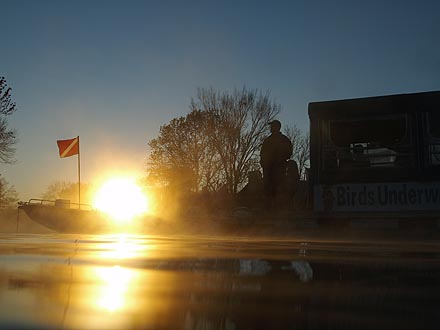
As for Manatees, this time the captain didn't spend time looking for them and their telltale bubbles but headed straight for the entrance to the Three Sisters spring system. They are more plentiful in the winter and tour operators know where they hang out. Outside the springs' entrance was a "Manatee Sanctuary," an area corded off with a floating rope. There were dozens in there, and a good number were roaming around outside. We got into the water and began snorkeling and admiring the Manatees. Last time I had seen them they'd all been eating, munching on sea grass and other greenery non-stop. This time, they were tired and spent most of their time sleeping, resting at the bottom with their peculiar looking snouts seemingly buried in the silt. Every few minutes they'd come up for a brief breath, sticking just the tops of their noses out of the water. They often took two such breaths, then sank back down and continued their motionless sleep.
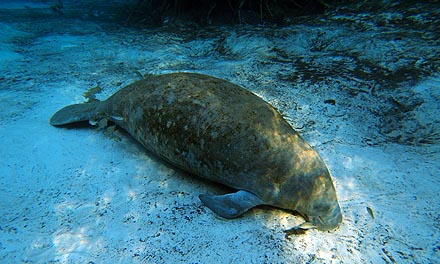
We headed up the entry into Three Sisters where there were more Manatees. The water wasn't quite as clear as last time and so we experimented with the big Evolt whose huge glass lens in front of the 11-22mm wide angle lens (really 22-44mm in 35mm film terminology) has a very large diameter. We thought it'd be cool to position the camera so that part of the lens was above water and part below, for a special effect. That indeed yielded interesting shots and some equally interesting phenomena. For example, the width of the divider between the underwater and the above water world depended not only on the shutter speed, but also on the movement of the water. A bit of wave action made for a big "divider" whereas a still surface made for a much narrower and more interesting one. Nothing Photoshop couldn't fix.
Eventually we swam back out of the spring system and into the main arm of the river. As I exited I saw a congregation of Manatees and decided to take a closer look. I snorkeled over without ever looking up and took some nice shots of the magnificent creatures. Noone else was around, and there was a good reason. I had inadvertently entered the Manatee Sanctuary! How embarrassing. I don't know if it's possible to be red-faced in the water. If it is, I certainly was. The captain later told me he'd seen someone inside the sanctuary and hoped it wasn't one of his group. However, I was not the only transgressor. Up in the spring system we had encountered a videographer with an IMAX camera and two very bright lights that he kept training on the Manatees. That is in strict violation of the Manatee preservation rules and caused outrage on our boat. A photographer and videographer who was there to shoot on behalf of the Manatee habitat at the Cincinnati Zoo had recorded the violation and said he was going to alert the fish and wildlife department.
Drift diving Rainbow River
In the afternoon it was on to a lesson in drift diving. Drift diving is a special skill as it requires going with the current and letting yourself "drift" down a river or other body of water. Fighting the current makes no sense and is not the objective; catching it and drifting along with it, taking in the underwater scenery and just generally having a great time is.
We had filled our tanks at Birds Underwater and loaded our gear onto the tour boat that would take us up Rainbow River. The boat itself had to be towed there. Once at the starting point, a nice county park with the somewhat odd name of K.P. Hole, we donned our scuba gear and got on the boat. Captain Rudy explained the rules and scenery. Rainbow is a five mile stretch of river starting with a spring and ending where it enters Withlacoochee River. The springs are strong, making for a 3mph current, and so the water of the entire river body is turned over several times a day. This means the water is almost always totally clear and only gets murky from human intervention. Yes, a single diver can silt up the water pretty good, as I know all too well from my own early transgressions. Rudy explained that the grass at the bottom acts as a natural filter. He said we'd see brown clumps of dirt clinging to it; all the stuff the grass removes from the water. Disturbing the grass dislodges the dirt and silts up the water.
We arrived at the drop off point and split into a diver and a snorkeler group, with the snorkelers in charge of the dive flag. I was one of the first ones off the boat and found the current surprisingly strong. So strong, in fact, that I almost missed the dock at the river shore and had to pull myself up with my hands into the calmer area behind the dock where all the divers assembled. One of the snorkelers, a fairly large older woman, entered the water for what was to be her first such snorkeling experience. She seemed apprehensive from the start and had complained about the tight fit of the wetsuit, and then quickly panicked in the strong current. She made it back to the boat and held on to it, making for some scary moments. Captain Rudy calmed her down but she decided she was not up to it. A diver from our group suddenly found that she'd lost her weights. Fortunately for her, they were found.
Then we were ready to start the estimated two-hour drift dive downriver. Down we went and I almost immediately realized I had made a big mistake: I used a brand-new mask for the first time on a long dive in an unfamiliar environment. After the Manatee tour I had found the new ScubaPro Wide Vu mask and had fallen in love with it. It fit extraordinarily well and so I had bought it at Birds Underwater. As recommended, I had used toothpaste to get off the factory-applied coating of the inside surface of the lens. I thought I'd done a good job, but the mask fogged up immediately, despite liberal use of defogger. I used spit in a last ditch attempt to keep the mask from misting, but to no avail. So down I went into this unfamiliar dive spot and unfamiliar kind of diving.
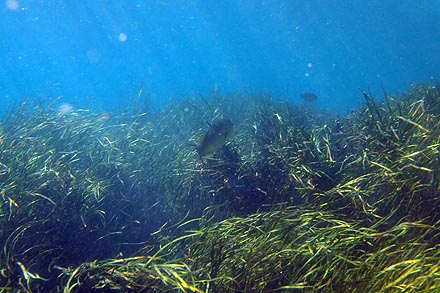
Drift diving was totally different from what I expected. I thought I'd be able to essentially see the whole river from side to side and then gently and slowly drift downstream while enjoying the scenery. Instead, I found myself almost lost in a confusing, meandering landscape of tall sea grass meadows with winding channels running through them. The water was shallow and so you had to stay close to the bottom while trying not to touch the grass. I had a hard time seeing my fellow divers, let alone the entire width of the river. The current was fairly strong, but it wasn't the kind that simply carries you along. Instead, the water pulled me so I could never just hover, but without giving me a good sense of direction or any degree of stability. I almost immediately felt lost and struggled to maintain proper buoyancy and even basic stability. Sometimes I felt close to being flipped over. What made it worse was that I could barely see through the fogged lens of my mask. I even flooded and then cleared the mask a couple of times, but it almost immediately fogged up again. So in addition to feeling rather lost and uncomfortable, I couldn't see a thing and braced myself for a rather long two hours.
Another problem I had not anticipated was the constant ear equalizing in the ever-changing depth of the river which averages about five feet. So it's up to four feet, down again to 12, up to five, down again to ten, then perhaps fifteen and back up. And so on and so on. Each new descent required new equalizing and I found I didn't enjoy that very much at all. Eventually I managed to find a bit of a rhythm in making my way through the sea grass or following one of the paths through it, but I still could see almost nothing.
Turns out Carol had similar problems with her mask, also one she had purchased just hours before. It was a Scubapro Frameless, a mask that she was very familiar with (she wears noting but), but it still leaked on her as the silicone skirt had not gotten used to her face, or developed a "face memory" as she put it. Since this was my first drift dive she insisted we swap masks. I reluctantly agreed and wearing her Frameless made a huge difference. I could finally see and began enjoying the ever-changing scenery, never knowing what would be beyond a field of sea grass and stopping to examine one of the numerous "boiling" sand areas where spring water emerged from the river bottom. You had to hold onto something to stop, and so I didn't take many pictures. My colleagues on this dive also seemed to struggle and often surfaced to regroup. My new mask fogged up on Carol as much as it had on me, plus it was too big for her face and leaked. She ended up keeping it a quarter-filled with water that she kept swirling around to keep the fogging at bay. It was clearly not a pleasant experience for her and I think we both learned a lesson.
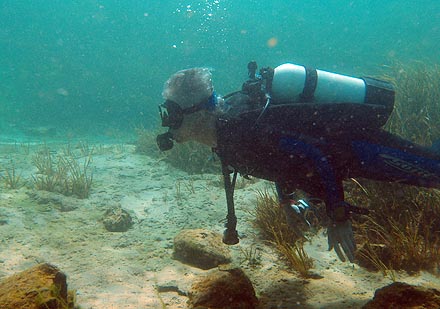
No matter how hard I tried to elegantly hover a foot above the bottom, never stirring up silt, always being perfectly neutrally buoyant, it was hard and I mostly failed miserably. I used my hands much too often. I held on to seagrass, grabbed for whatever rocks or roots or logs I could find, and groped at and into things I felt I perhaps shouldn't. I asked myself if newcomers shouldn't wear gloves when they go drift diving. The Olympus camera, without a protective case, dangled from the carry strap around my wrist, got dragged along the sand and rocks, and bumped into stuff so much I was afraid it'd be all scratched up. It didn't, but that's one of the drawbacks of not having a tough protective case.
I had wondered how I was supposed to do a two-hour dive on a little 65 cuft tank. Supposedly that was possible because of the shallow water and little exertion required. Well, for me the exertion wasn't that little and I gulped down quite a bit of air while trying to stay on even keel and going to where I wanted to go. So I nervously kept checking my air supply and quickly realized there was no way it was going to last me two hours.
I had hoped to see some exotic wildlife or at least a turtle or two, but there was little more than the usual variety of small fish. The sole exception was a menacing looking alligator gar, a big one, with his long mean-looking snout open. Those guys have a dual row of large teeth in the upper jaw and get as long as eight to twelve feet. This one looked like a particularly sinister Barracuda and he definitely wasn't small. I wanted to take a picture... just to find that my battery had gone dead.
Eventually I found myself quite a bit ahead of the group and decided to surface when I found a boat anchor line. It turned out to be our boat, waiting for us near the starting point. I was perhaps a hundred yards ahead and waited for the rest to arrive. Rudy pointed to the other side of the river and said this was where the small cavern was. So we dived over to take a look. As always, I approached it carefully, holding on to rocks and outcroppings. It was a small cavern, but I did go inside, after Carol, and looked around. That was the end of the drift dive. It had lasted about an hour and a half, and I was down to my last 300 pounds of air or so. I was both giddy with excitement and very tired when I got out of the water and walked back to the car.
Beneath Green Pond
The final dive of the trip took me back to Manatee Springs State Park and the Catfish Hotel sink. I am still not entirely sure why they call it that as I never saw a single sizeable catfish in there. Perhaps they are in the cave system. I wouldn't know.
After that 19-year-old had died in the sink a few days before, I wondered whether the park would institute new restrictions. At Birds Underwater I had talked to a man who worked at the shop and had been at Catfish Hotel the day of the accident. I learned that it hadn't been three kids, but the one kid from Texas and then a dive master and a scuba instructor from a local dive shop not far from Crystal River. The kid had been affiliated with the dive shop and so maybe they were showing him around the local dive places. Somehow the two experienced divers ascended when they couldn't see their young buddy, assuming he'd already gone up. He hadn't. One of them went back down and entered the downstream cave system where he found the young diver, apparently wedged in somewhere, already dead. He could not get him loose and so went back up. When the body was recovered it appeared he had bumped into something hard, incurred substantial injuries, and had perhaps gotten knocked out. The sheriff was screaming at the experienced divers for letting that happen.
We got to the park somewhat late and found nothing changed. No new signs or restrictions, no mention at the ranger's station at the entrance of the park where you sign up, pay the US$10.50 fee for diving, and hand in your scuba certification card. This time we weren't alone. Several teams were diving, and not just open water divers.
We drove to the parking lot and walked over to check out the situation at sink. It was as green as last Fall, totally covered with duckweed. Duckweed is the smallest flowering plant in existence and it grows in still or slowly moving water. It's not slimy but it can sure take over. The vegetation around the sink apparently had dropped some foliage and so the sink itself somehow seemed smaller although the water level was the same. Several divers were floating by or off the entry platform. We talked to some and it quickly become obvious they were cave divers, and experienced ones at that. They wore their doubles, had stage bottles, and each had not one but two scooters. I can't remember all they'd said but apparently they'd gone in almost all the way to the end of the 10,000 feet cave system. One of them wondered how Sheck Exley had ever made it that far just swimming against the current.
We went back to the car to don our gear and passed other divers. One group returned to their truck that was parked next to us as we geared up. Once again the wetsuit practically just slid on and I was amazed (and thankful) at the huge difference a bit of humidity can make. I checked the two cameras I was going to take diving - a Casio EX-Z700 in a clear acrylic deepwater housing and, once again, the Olympus 770 SW - and then we walked back to the sink. 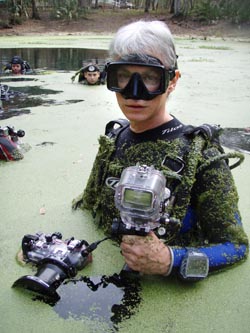 I was first to get into the green duckweed that quickly covered everything. We took pictures of ourselves floating in duckweed, wondered how the cameras were going to handle THAT challenge, felt a bit guilty for taking the expensive Olympus Evolt setup into the mess, and worried about visibility with all those divers. I put my head underwater to take a look around and it indeed seemed darker and nowhere near as clear as last Fall when we had he sink totally to ourselves. I feared it'd be essentially a no-viz dive and that wasn't a pleasant thought.
I was first to get into the green duckweed that quickly covered everything. We took pictures of ourselves floating in duckweed, wondered how the cameras were going to handle THAT challenge, felt a bit guilty for taking the expensive Olympus Evolt setup into the mess, and worried about visibility with all those divers. I put my head underwater to take a look around and it indeed seemed darker and nowhere near as clear as last Fall when we had he sink totally to ourselves. I feared it'd be essentially a no-viz dive and that wasn't a pleasant thought.
We signaled each other and went down, with me again feeling no apprehension at all. It became immediately clear that the water was still plenty clear enough to provide a view of the entire sink in all its majesty. I lowered myself a bit to assess the situation and adjust my buoyancy. My dive buddy motioned to me and pointed behind me. Ouch. Clouds of sand and silt. Apparently I had kicked up a good bunch of silt while getting buoyancy right. I mentally slapped myself.
Then we headed for the deeper end and the dark outline of the cavern entrance. This was going to be another challenge for the Olympus. It had already handled over 50 feet at Devil's Den, but the Catfish sink was deeper yet. I approached the sloping entrance to the cavern cautiously, as usual. I clung to the bottom, always made sure I had something to hold onto, and lowered myself foot by foot beneath the dark overhang above us. Depth 63 feet. At that moment, I admit, the only thing on my mind was breaking my old "record" of 65 feet and so I improvised hand signals to my buddy indicating I wanted to go three feet deeper. She'd already motioned to go back up but then gave me the OK sign. So I carefully lowered myself another few feet and now my dive computer showed 67 feet. Somehow I was elated at that and would have gone down a bit deeper yet had my buddy not stopped her descent and started working with the big Evolt.
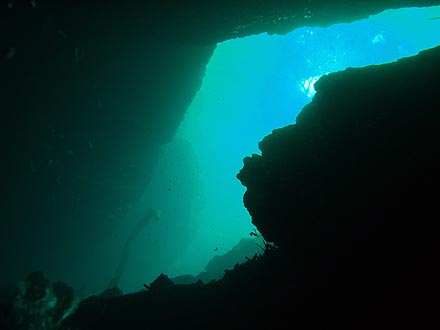
I laid there looking up, seeing the greenish light past the pitch-black overhang of the cavern entrance, studied the logs in the water and couldn't get enough of the view.
Then I turned my attention to my cameras and began taking pictures. It quickly became evident that the Casio, set to its sole underwater mode, used the flash no matter what and so, despite the snap-on diffuser plate in front of its internal flash, it simply lit up scatter. The Olympus, at more than twice its rated depth, was still alive, but once again it was impossible to select modes and the camera was in full telephoto mode though I hadn't extended the zoom. I studied the buttons and noticed that some seemed fully depressed. The mode button, especially, was pushed in all the way from the water pressure. I took some shots, not knowing what to expect, then alerted my buddy to the phenomenon. Though this time we both wore masks that worked for us (I had my trusted ScubaPro Frameless, she had her new Frameless that apparently now memorized her face) she looked uneasier than I remembered ever having seen her underwater and so we slowly began to ascend. There was much to see and do and we began exploring the scenery and taking pictures. As usual, the Olympus controls returned to normal operation at around 40 feet. We took close-ups of the cameras underwater, with their LCDs displaying what they saw.
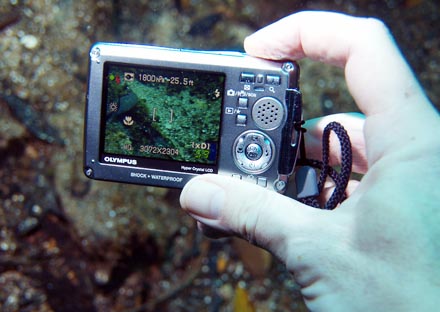
On the other side of the sink, opposite of the main cavern, I noticed another, smaller cavern and swam to it to investigate. It was a dark hole and I wondered it that was the entrance to the upstream cave. That would have meant water rushing out of it and thus safety, but I decided to be extra careful and only peeked in a bit. Carol did not follow and I took that as a sign not to venture farther. I then laid on a ledge just watching the cavern. Then took some macro shots and found a few holes in the vertical limestone wall. I peeked into some and again wished I'd have a light but also understood why the park insisted on open water divers not taking one down. One of the reasons why I took it easy was that I had such a great time. The other was that I wanted to make this a one-hour-plus dive. As usual I tried to conserve air, but my little 65 cuft tank soon got dangerously low. I finally emerged after 65 minutes with less than 200 psi of pressure left.
Duckweed made the exit a riot. It was simply everywhere. So while basking in the usual mix of slight headache and afterglow we played with the stuff, took pictures and I took a bunch of breaths from Carol's Nitrox tank that still had 1200 psi in it. Though it had twice the oxygen I didn't really feel a difference, but also didn't expect to after just a half dozen breaths.
Eventually we walked up the wooden stairs and used the makeshift shower and hose to rid ourselves of as much duckweed as we could. That was no easy task as it not only gets EVERYWHERE, but also can't easily be washed off. Apparently the best way is to wash off what you can, and then wait until the rest is dry when it becomes easy to blow it off.
On the way back Carol confided she'd been cold almost right off the bat in her 3mm wetsuit and also had been very conscious of the depth limit for the 42% oxygen she had in her Nitrox tank. There are calculations that determine how deep you can go without exceeding a given maximum partial oxygen pressure, the level where oxygen toxicity might become an issue and, in a worst case scenario, lead to convulsions. The generally accepted safe number is 1.4, or a PPO2 of 1.4 - Partial Pressure Oxygen. In her case the depth limit was something like 79 feet, so we'd only gotten to ten feet of it, but she's so experienced that I felt she'd have her reasons for not wanting to go deeper.
It was getting close to five PM which was the time we had to collect our C-Cards from the Ranger Station. We got there a few minutes after and saw on the white board that two or three dive groups had still not returned. I asked the ranger if she breathed a sigh of relief every time a group came back to collect their cards and she said yes.
Later, over dinner, we all discussed our experiences. For me it was yet another instance of not encountering the expected and instead run into other issues. Given that the diving accident had preoccupied me ever since I' read about it, that I had written and talked about it, it really wasn't on my mind when we got there. Once again, I didn't feel the least bit of apprehension going down. When laying at the bottom as deep into the cavern as I dared to go, I marveled at the views and the light and putzed with the cameras. Before the dive I had been anticipating finding the exact spot where Sheck Exley had taken his picture, printed in "Caverns Measureless to Man" and duplicating it. Yet, Sheck barely entered my mind while I was down there. Even more amazingly, the fatal accident didn't either. The cavern didn't feel any more menacing, nor was I afraid. I had my usual healthy respect, but nothing more. I did not peek into the black below me and wonder what had happened to the young diver and what his last moments had been like. I did change my views on being able to get separated in the sink. If visibility is poor and one ventures into the cavern area, it's possible to lose sight of one another. But in order for that to happen, you do have to go deeper into the dark than is advisable, especially without a light.
Turns out it had been different for others. Some knew about the accident, some did not. Most seemed to simply take it as an unfortunate accident, like the death of the lady who'd died after the Manatee snorkel tour. It had been different for Carol. She told me later how she'd felt apprehension and a shiver down there near the cavern entrance, and it had not only been the cold or the fear of the approaching Nitrox depth limit. She related how divers in trouble often start doing irrational things as the situation becomes desperate. Scratch at things, drop equipment, rip off their masks or regulators. She had eerie feelings and she did not want to find some telltale mark or piece of equipment left by the young man who had died close to there just days before. A young man that had gone from the thrill of getting his Adventure Dive card to losing his life in a sink in northern Florida. I guess it's all part of it.
So there. My first dives of 2007. Every minute underwater was worth it. I thrilled in it. I screamed and laughed with joy whenever I surfaced. The equipment seemed to weigh less. My wetsuit went on easy and I never had the problem with the sides of my fingernails digging into the soft skin of my fingertips until they became infected as they had last Fall. My back, which had been acting up some before the trip, never once hurt as I feared might happen with all the heavy equipment. Not once. I'd learned to drift dive. I ran into silly new-diver mistakes and committed them all to memory so I would not make them again. I forgot only one thing, my dive log. Not a big deal as bad as my Uwatec Smart Z dive computer logs and memorizes all of my dives. I had fun and ample time with reviewing all those cameras underwater. I got to listen to other divers and exchange stories. I found I was no longer afraid right before going under. And that I enjoy scuba tremendously.
I want to go back right now.
Posted by conradb212 at February 26, 2007 11:09 PM








